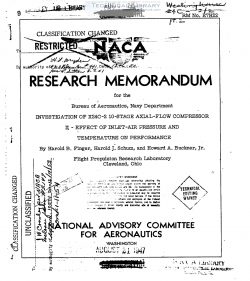naca-rm-e7h22
- Version
- 39 Downloads
- 1.64 MB File Size
- 1 File Count
- April 21, 2017 Create Date
- April 21, 2017 Last Updated
National Advisory Committee for Aeronautics, Research Memorandum - Investigation of X24C-2 10-Stage Axial-Flow Compressor - II - Effect of Inlet Air Pressure and Temperature on Performance

An investigation was made to determine the effects of inlet—
air pressure and temperature on the perfomame of the 10-5th
axial-flow compressor from the nee-2 turboJet engine. The inves-
tigation was conducted for Speeds of 80, 89, and 100 percent of
equivalent design speed with inlet-air pressures of 6 and 12 inches
of mercury absolute (4.24 and 849 l'b/sq ft) and inlet—air tempera-’
tures of approximately 558°, 459°, and 419° R (79°, 0°, and -40° F).
The results of the investigation of the effect of inlet-air pres-
sure were compared with the results of the previous performance
investigation at a nominal inlet-air pressure of 21 inches of mer-
cury absolute (1435 lb/sq ft) and an inlet-air temperature of
approximately 558° E to give a larger range of inlet-air pressures.
The peak values of adiabatic temperature-rise efficiency and
pressure ratio were found to decrease as the inlet-air pressure
was reduced at constant inlet-air temperature. The effect of
inlet-air pressure on equivalent weight flow was small, the rela-
tive deviation reaching a maximum of about 1 percent. Variations
in inlet-air temperature had only a slight effect on the same per—
formance parameters. All data obtained at various inlet-air pres-
sures and inlet-air temperatures correlated on two curves when the
polybropic efficiency was plotted as a function of the polytropic
loss factor.
The only effect of inlet-air pressure was to increase the
minimum loss factor and to decrease the maximum poly-tropic
efficiency as the inlet-air pressure was reduced. The corre-
sponding effect of temperature was negligible. Peak adiabatic
temperature—rise efficiency and pressure ratio increased with
increasing Reynolds number. The fact that the range of Reynolds
number covered in varying the inlet-air pressurewas considerably
larger than that obtained by varying the inlet-air temperature,
shows that the largest effect of a change in altitude will be due
to the change in pressure. A study of the interstage static-
pressure data, obtained during this investigation, was made to
determine the performance of each compressor component.
| File | Action |
|---|---|
| naca-rm-e7h22 Investigation of X24C-2 10-Stage Axial-Flow Compressor - II - Effect of Inlet Air Pressure and.pdf | Download |

Comment On This Post